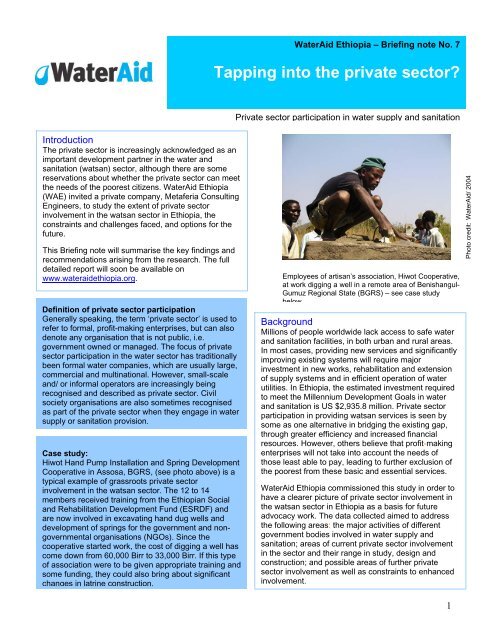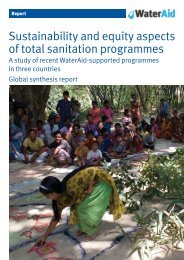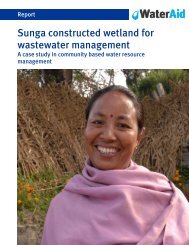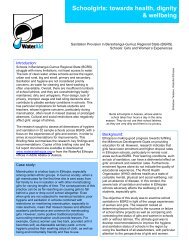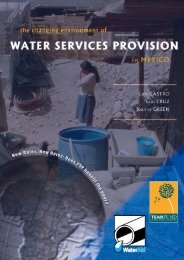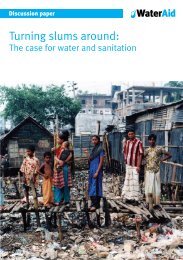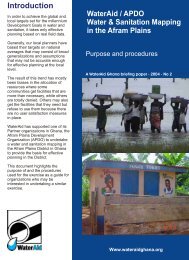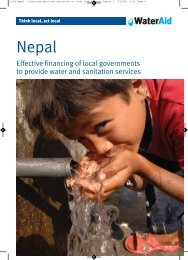Private Sector Participation in water supply and sanitation - WaterAid
Private Sector Participation in water supply and sanitation - WaterAid
Private Sector Participation in water supply and sanitation - WaterAid
You also want an ePaper? Increase the reach of your titles
YUMPU automatically turns print PDFs into web optimized ePapers that Google loves.
<strong>WaterAid</strong> Ethiopia – Brief<strong>in</strong>g note No. 7Tapp<strong>in</strong>g <strong>in</strong>to the private sector?<strong>Private</strong> sector participation <strong>in</strong> <strong>water</strong> <strong>supply</strong> <strong>and</strong> <strong>sanitation</strong>IntroductionThe private sector is <strong>in</strong>creas<strong>in</strong>gly acknowledged as animportant development partner <strong>in</strong> the <strong>water</strong> <strong>and</strong><strong>sanitation</strong> (watsan) sector, although there are somereservations about whether the private sector can meetthe needs of the poorest citizens. <strong>WaterAid</strong> Ethiopia(WAE) <strong>in</strong>vited a private company, Metaferia Consult<strong>in</strong>gEng<strong>in</strong>eers, to study the extent of private sector<strong>in</strong>volvement <strong>in</strong> the watsan sector <strong>in</strong> Ethiopia, theconstra<strong>in</strong>ts <strong>and</strong> challenges faced, <strong>and</strong> options for thefuture.This Brief<strong>in</strong>g note will summarise the key f<strong>in</strong>d<strong>in</strong>gs <strong>and</strong>recommendations aris<strong>in</strong>g from the research. The fulldetailed report will soon be available onwww.<strong>water</strong>aidethiopia.org.Def<strong>in</strong>ition of private sector participationGenerally speak<strong>in</strong>g, the term ‘private sector’ is used torefer to formal, profit-mak<strong>in</strong>g enterprises, but can alsodenote any organisation that is not public, i.e.government owned or managed. The focus of privatesector participation <strong>in</strong> the <strong>water</strong> sector has traditionallybeen formal <strong>water</strong> companies, which are usually large,commercial <strong>and</strong> mult<strong>in</strong>ational. However, small-scale<strong>and</strong>/ or <strong>in</strong>formal operators are <strong>in</strong>creas<strong>in</strong>gly be<strong>in</strong>grecognised <strong>and</strong> described as private sector. Civilsociety organisations are also sometimes recognisedas part of the private sector when they engage <strong>in</strong> <strong>water</strong><strong>supply</strong> or <strong>sanitation</strong> provision.Case study:Hiwot H<strong>and</strong> Pump Installation <strong>and</strong> Spr<strong>in</strong>g DevelopmentCooperative <strong>in</strong> Assosa, BGRS, (see photo above) is atypical example of grassroots private sector<strong>in</strong>volvement <strong>in</strong> the watsan sector. The 12 to 14members received tra<strong>in</strong><strong>in</strong>g from the Ethiopian Social<strong>and</strong> Rehabilitation Development Fund (ESRDF) <strong>and</strong>are now <strong>in</strong>volved <strong>in</strong> excavat<strong>in</strong>g h<strong>and</strong> dug wells <strong>and</strong>development of spr<strong>in</strong>gs for the government <strong>and</strong> nongovernmentalorganisations (NGOs). S<strong>in</strong>ce thecooperative started work, the cost of digg<strong>in</strong>g a well hascome down from 60,000 Birr to 33,000 Birr. If this typeof association were to be given appropriate tra<strong>in</strong><strong>in</strong>g <strong>and</strong>some fund<strong>in</strong>g, they could also br<strong>in</strong>g about significantchanges <strong>in</strong> latr<strong>in</strong>e construction.Employees of artisan’s association, Hiwot Cooperative,at work digg<strong>in</strong>g a well <strong>in</strong> a remote area of Benishangul-Gumuz Regional State (BGRS) – see case studybelowBackgroundMillions of people worldwide lack access to safe <strong>water</strong><strong>and</strong> <strong>sanitation</strong> facilities, <strong>in</strong> both urban <strong>and</strong> rural areas.In most cases, provid<strong>in</strong>g new services <strong>and</strong> significantlyimprov<strong>in</strong>g exist<strong>in</strong>g systems will require major<strong>in</strong>vestment <strong>in</strong> new works, rehabilitation <strong>and</strong> extensionof <strong>supply</strong> systems <strong>and</strong> <strong>in</strong> efficient operation of <strong>water</strong>utilities. In Ethiopia, the estimated <strong>in</strong>vestment requiredto meet the Millennium Development Goals <strong>in</strong> <strong>water</strong><strong>and</strong> <strong>sanitation</strong> is US $2,935.8 million. <strong>Private</strong> sectorparticipation <strong>in</strong> provid<strong>in</strong>g watsan services is seen bysome as one alternative <strong>in</strong> bridg<strong>in</strong>g the exist<strong>in</strong>g gap,through greater efficiency <strong>and</strong> <strong>in</strong>creased f<strong>in</strong>ancialresources. However, others believe that profit-mak<strong>in</strong>genterprises will not take <strong>in</strong>to account the needs ofthose least able to pay, lead<strong>in</strong>g to further exclusion ofthe poorest from these basic <strong>and</strong> essential services.<strong>WaterAid</strong> Ethiopia commissioned this study <strong>in</strong> order tohave a clearer picture of private sector <strong>in</strong>volvement <strong>in</strong>the watsan sector <strong>in</strong> Ethiopia as a basis for futureadvocacy work. The data collected aimed to addressthe follow<strong>in</strong>g areas: the major activities of differentgovernment bodies <strong>in</strong>volved <strong>in</strong> <strong>water</strong> <strong>supply</strong> <strong>and</strong><strong>sanitation</strong>; areas of current private sector <strong>in</strong>volvement<strong>in</strong> the sector <strong>and</strong> their range <strong>in</strong> study, design <strong>and</strong>construction; <strong>and</strong> possible areas of further privatesector <strong>in</strong>volvement as well as constra<strong>in</strong>ts to enhanced<strong>in</strong>volvement.1Photo credit: <strong>WaterAid</strong>/ 2004
MethodologyThe research consisted of a comb<strong>in</strong>ation of desk-basedstudies <strong>and</strong> field research <strong>in</strong> the capital Addis Ababa, <strong>in</strong>Adama, Oromia Region, <strong>and</strong> <strong>in</strong> Assosa, Benishangul-Gumuz Region: all areas where <strong>WaterAid</strong> Ethiopia isactive. Telephone <strong>in</strong>terviews were also conducted <strong>in</strong>two additional regions.Information was collected from a range of levels ma<strong>in</strong>lywith<strong>in</strong> the private sector but also <strong>in</strong>clud<strong>in</strong>g keygovernment personnel. Informants ranged from smallscaleartisans <strong>and</strong> government staff work<strong>in</strong>g atgrassroots level, to large national companies <strong>and</strong>government policy makers. Approximately 30<strong>in</strong>terviews were conducted <strong>in</strong> total.The <strong>in</strong>tensive desk research consisted of a literaturereview of previous documents <strong>and</strong> studies related toprivate sector participation <strong>in</strong> the watsan sector<strong>in</strong>ternationally, <strong>and</strong> a review of the key relevant laws,strategies, policies, programmes <strong>and</strong> manuals <strong>in</strong> theEthiopian context.Key f<strong>in</strong>d<strong>in</strong>gsInternational backgroundPreviously, the role of the private sector <strong>in</strong> the watsansector was seen as restricted to consultancy,construction <strong>and</strong> goods <strong>supply</strong>. S<strong>in</strong>ce the late 1990s,private sector participation has exp<strong>and</strong>ed to play alarger role, especially <strong>in</strong> <strong>in</strong>dustrialised countries suchas the UK, USA <strong>and</strong> France. Develop<strong>in</strong>g countries are<strong>in</strong>creas<strong>in</strong>gly follow<strong>in</strong>g their lead, after heavy promotionof the benefits of private sector <strong>in</strong>volvement bygovernments <strong>and</strong> multilateral agencies. The WorldBank currently lists more than 100 countries <strong>in</strong> Asia,Africa <strong>and</strong> Lat<strong>in</strong> America where private companies playa major role <strong>in</strong> <strong>water</strong> <strong>supply</strong> <strong>and</strong> <strong>sanitation</strong> provision.However, there has been vehement opposition<strong>in</strong>ternationally by those who believe that the privatesector will ignore the needs of the poor because of theirobligation to make a profit.For <strong>and</strong> aga<strong>in</strong>st private sector participationThose who advocate for the benefits of the privatesector as a supplier of basic services argue that thepublic sector is characterised by <strong>in</strong>efficiency,mismanagement <strong>and</strong> conflict<strong>in</strong>g <strong>in</strong>terests. They believethat the private sector would <strong>in</strong>troduce technical <strong>and</strong>managerial efficiency, expertise <strong>and</strong> new technologies;improve economic efficiency <strong>in</strong> operationalperformance <strong>and</strong> capital <strong>in</strong>vestment; <strong>in</strong>ject large scale<strong>in</strong>vestment or ga<strong>in</strong> access to private capital markets;reduce public subsidies or redirect them more directlyto the poor; <strong>in</strong>sulate basic services from short termpolitical <strong>in</strong>tervention <strong>and</strong> limit <strong>in</strong>tervention by powerful<strong>in</strong>terest groups; <strong>and</strong> make services more responsive toconsumer needs <strong>and</strong> preferences through the<strong>in</strong>troduction of bus<strong>in</strong>ess oriented pr<strong>in</strong>ciples. Others feelthat the <strong>in</strong>volvement of the private sector <strong>in</strong> the watsansector will further disadvantage the poor. Many th<strong>in</strong>kthat private sector participation will <strong>in</strong>crease tariffs, <strong>and</strong>therefore favour high-<strong>in</strong>come consumers to thedetriment of the poor <strong>and</strong> social development goals.Ethiopian contextUntil 1991, Ethiopia’s economy was heavily controlledby the state. Major reforms s<strong>in</strong>ce then have seen manystate owned enterprises sold to private companies, withrestrictions on non-local <strong>in</strong>vestors <strong>in</strong> a number ofcases. Public <strong>in</strong>frastructure rema<strong>in</strong>s underdeveloped,even by sub-Saharan Africa st<strong>and</strong>ards, <strong>and</strong> thegovernment lacks the f<strong>in</strong>ancial or skills resources toaddress the issue without some form of private sector<strong>in</strong>volvement. The most common form of private sectorparticipation <strong>in</strong> the watsan sector is through servicecontracts, or private firms compet<strong>in</strong>g for governmenttenders to render various services. This <strong>in</strong>volvesm<strong>in</strong>imum private sector responsibility; see table below.Table: Allocation of key responsibilities <strong>in</strong> different private sector participation optionsIncreas<strong>in</strong>g private participationServicecontractManagementcontractAffermage Lease Concession Build-owntransfer(BOT) typeDivestureAsset ownership Public Public Public Public Public <strong>Private</strong>/publicCapital <strong>in</strong>vestment Public Public Public Public <strong>Private</strong> <strong>Private</strong> <strong>Private</strong><strong>Private</strong>Commercial risk <strong>Private</strong> Public Shared Shared <strong>Private</strong> <strong>Private</strong> <strong>Private</strong>Operations/<strong>Private</strong>/ <strong>Private</strong> <strong>Private</strong> <strong>Private</strong> <strong>Private</strong> <strong>Private</strong> <strong>Private</strong>ma<strong>in</strong>tenancepublicContract duration (years) 1-2 3-5 8-15 25-30 25-30 20-30 Indef<strong>in</strong>ite2
Photo credit: <strong>WaterAid</strong> Ethiopia/ 2005Tap attendants play an important role <strong>in</strong> <strong>water</strong> provision<strong>and</strong> hygiene education at grassroots level.Key players <strong>in</strong> the Ethiopian watsan sectorEthiopia is a federal state, with powers transferred toregional level, <strong>and</strong> further devolved to local woreda <strong>and</strong>kebele levels, with supervisory, policy mak<strong>in</strong>g <strong>and</strong>technical assistance bodies at federal level. TheM<strong>in</strong>istry of Water Resources is responsible fordevelop<strong>in</strong>g policies, rules, regulations <strong>and</strong> guidel<strong>in</strong>es,<strong>and</strong> for sett<strong>in</strong>g st<strong>and</strong>ards <strong>and</strong> procedures. The Water<strong>Sector</strong> Development Programme states that <strong>water</strong><strong>supply</strong> <strong>and</strong> <strong>sanitation</strong> activities at regional level are theresponsibility of regional bureaux; therefore, regional<strong>water</strong> bureaux are the ma<strong>in</strong> implementers <strong>in</strong> thewatsan sector, with funds from federal government,NGOs <strong>and</strong> multilateral <strong>in</strong>stitutions. Zonal <strong>and</strong> woredalevel authorities work under regional authorities <strong>in</strong>small-scale design, plann<strong>in</strong>g, implementation <strong>and</strong>ma<strong>in</strong>tenance works. Recent reforms have given town<strong>water</strong> <strong>supply</strong> services greater autonomy, <strong>in</strong> order toencourage bus<strong>in</strong>ess-oriented pr<strong>in</strong>ciples such as costrecovery.<strong>Private</strong> sector <strong>in</strong>volvement <strong>in</strong> the watsan sector isma<strong>in</strong>ly limited to contractors, consultants, suppliers,artisans <strong>and</strong> tap attendants (see picture above). Thereare restricted numbers of consultants <strong>and</strong> contractors<strong>in</strong> the sector; for example, there are only 21 privateconsultants work<strong>in</strong>g <strong>in</strong> the watsan sector, with the vastmajority based <strong>in</strong> Addis Ababa. Very few of theregistered contractors <strong>in</strong> Ethiopia work <strong>in</strong> <strong>water</strong> <strong>supply</strong>,except for drill<strong>in</strong>g companies, <strong>and</strong> suppliers <strong>and</strong>manufacturers are also limited <strong>in</strong> number. <strong>Private</strong>companies work<strong>in</strong>g <strong>in</strong> the <strong>sanitation</strong> sector are evenless, with only a h<strong>and</strong>ful of private firms <strong>in</strong>volved <strong>in</strong>vacuum clean<strong>in</strong>g septic tanks or solid waste collection<strong>in</strong> major towns. <strong>Private</strong> ma<strong>in</strong>tenance <strong>and</strong> managementactors are not yet <strong>in</strong>volved <strong>in</strong> provid<strong>in</strong>g any watsanservices <strong>in</strong> the country.Legal issuesWatsan sector analysts agree that an appropriate <strong>and</strong>clear legal <strong>and</strong> regulatory framework is crucial to thesuccess of private sector participation; therefore, it ispreferable for <strong>in</strong>creased private sector <strong>in</strong>volvement tobe preceded by a range of policy reform measures.In the watsan sector <strong>in</strong> Ethiopia, regions haveproduced their own policy frameworks, while theM<strong>in</strong>istry of Water Resources reta<strong>in</strong>s the overallresponsibility for <strong>water</strong> resource development <strong>and</strong>management, <strong>in</strong>clud<strong>in</strong>g issu<strong>in</strong>g permits forconstruction, ma<strong>in</strong>tenance or alteration of <strong>water</strong> works.While policies acknowledge the importance ofpartnership with the private sector <strong>in</strong> construction,consultancy <strong>and</strong> <strong>supply</strong>, there is no legal or <strong>in</strong>stitutionalframework for the private sector to be <strong>in</strong>volved <strong>in</strong>management or service provision.Constra<strong>in</strong>ts to private sector <strong>in</strong>volvementThe Water <strong>Sector</strong> Development Programmeacknowledges that the watsan sector <strong>in</strong> Ethiopiasuffers from a serious lack of capacity, especially <strong>in</strong> thegovernment but also <strong>in</strong> the private sector. Manyexperienced professionals have left for better-paid jobs<strong>in</strong> more affluent countries, leav<strong>in</strong>g much of theEthiopian watsan sector to junior <strong>and</strong> <strong>in</strong>experiencedstaff, many without adequate tra<strong>in</strong><strong>in</strong>g. <strong>Private</strong> sectoractors strongly voiced their concerns, especially aroundissues of excessive bureaucracy <strong>and</strong> unnecessarydelays. The problem of failure to assume responsibilityfor decisions is another major drawback l<strong>in</strong>ked toissues of low capacity.F<strong>in</strong>ancial constra<strong>in</strong>ts are another major issue. Forcontractors <strong>and</strong> drillers, the absence of collateral is amajor impediment to obta<strong>in</strong><strong>in</strong>g loans, both short <strong>and</strong>long term. Bidd<strong>in</strong>g or <strong>in</strong>surance bonds are notacceptable <strong>in</strong> most bid procedures, <strong>and</strong> <strong>in</strong> addition theslow bidd<strong>in</strong>g process ties up cash that could be usedproductively <strong>in</strong> the meantime. Lack of access to fundsis also a problem for artisan associations: f<strong>in</strong>ancial<strong>in</strong>stitutions are mostly absent <strong>in</strong> rural or remote areas,<strong>and</strong> the restricted number of micro-credit organisationsdo not address the needs of construction companies,so artisan groups often have to pay high <strong>in</strong>terest tolocal moneylenders.The government is by far the dom<strong>in</strong>ant actor <strong>in</strong> thewatsan sector, but the division of roles <strong>and</strong>responsibilities between departments <strong>and</strong> bureaux isoften unclear. Furthermore, regional bureaux <strong>in</strong>particular are often overstretched, but do not outsourcework to the private sector, even when a private firmwould be quicker <strong>and</strong> cheaper. Many privatecompanies <strong>in</strong> the watsan sector, such as the HiwotCooperative <strong>in</strong> Assosa (see front page case study), are<strong>in</strong> danger of go<strong>in</strong>g out of bus<strong>in</strong>ess, while governmentagencies are overloaded, delay<strong>in</strong>g implementation.3
RecommendationsMeet<strong>in</strong>g the Millennium Development Goals (MDGs) on<strong>water</strong> <strong>and</strong> <strong>sanitation</strong> by 2015 will require a dramaticscal<strong>in</strong>g up of efforts, both <strong>in</strong> terms of the extent ofaction required <strong>and</strong> the speed with which these actionsmust be undertaken. Investment <strong>in</strong> the sector is one ofthe prerequisites to meet the 2015 MDGs. Susta<strong>in</strong>ableservice delivery is also of paramount importance, <strong>in</strong>addition to construct<strong>in</strong>g additional facilities. Thefollow<strong>in</strong>g is a summary of recommendations aris<strong>in</strong>gfrom the study on how the private sector can contributeto achiev<strong>in</strong>g the watsan goals <strong>in</strong> Ethiopia.• Introduc<strong>in</strong>g reform <strong>in</strong>to any sector requirescomplex efforts <strong>in</strong> which multiple <strong>in</strong>terests must bebalanced. Any reforms should enable communitiesto hold to account public officials, as well as public<strong>and</strong> private service providers, for their policies,actions <strong>and</strong> use of funds.• Adequate monitor<strong>in</strong>g, assessment, <strong>in</strong>formationgather<strong>in</strong>g <strong>and</strong> shar<strong>in</strong>g systems for watsan servicesneed to be active <strong>and</strong> adequately resourced fromregional to federal levels.• The government should be a regulatory <strong>and</strong>policymak<strong>in</strong>g body, rather than be<strong>in</strong>g <strong>in</strong>volved <strong>in</strong>direct implementation. It should revise exist<strong>in</strong>grules <strong>and</strong> regulations, as well as draft additionallaws relat<strong>in</strong>g to the <strong>in</strong>volvement of the privatesector <strong>in</strong> service <strong>and</strong> management contracts. Thismay require revitalis<strong>in</strong>g exist<strong>in</strong>g structures orcreat<strong>in</strong>g a new <strong>in</strong>stitution with sufficient watsansector experience.• In order to encourage the development of a smallscaleprivate sector, artisan associations should betax exempt up to a certa<strong>in</strong> threshold <strong>and</strong> supportshould be made available <strong>in</strong> other ways, such astra<strong>in</strong><strong>in</strong>g.• F<strong>in</strong>ancial constra<strong>in</strong>ts faced by the private sectorcould be alleviated by the M<strong>in</strong>istry of Infrastructurechang<strong>in</strong>g the requirements for bank guaranteesfrom requir<strong>in</strong>g high liquidity <strong>in</strong> favour of <strong>in</strong>suranceor advance payment bonds.• Before embark<strong>in</strong>g on reform, <strong>in</strong>creas<strong>in</strong>g capacity atregional <strong>and</strong> local levels should be a governmentpriority to overcome the problem of slow <strong>and</strong> nontransparenttender evaluation processes.• The roles of the M<strong>in</strong>istries of Health <strong>and</strong> WaterResources <strong>and</strong> of regional bureaux need to bemore clearly demarcated to avoid overlapp<strong>in</strong>gresponsibilities, especially <strong>in</strong> the <strong>sanitation</strong> sector.A committee should be formed to oversee<strong>sanitation</strong> activities.• The M<strong>in</strong>istry of Water Resources should implementrealistic licens<strong>in</strong>g requirements commensurate withthe available professional capacity <strong>in</strong> the country.• Government <strong>in</strong>stitutions currently have an unfairadvantage over the private sector <strong>in</strong> the watsansector. In order to level the play<strong>in</strong>g field, the role ofgovernment owned <strong>in</strong>stitutions should be redef<strong>in</strong>ed<strong>and</strong> <strong>in</strong>centives such as tax breaks extended toprivate associations.• A jo<strong>in</strong>t forum between public <strong>and</strong> privatestakeholders should be formed, for a process ofcont<strong>in</strong>uous consultation on division of roles <strong>and</strong>responsibilities <strong>in</strong> the watsan sector.Keywords<strong>Private</strong> sectorWater <strong>supply</strong>F<strong>in</strong>anceEthiopiaContactsBrief<strong>in</strong>g note: Sarah Howard, December 2005Full report: Anteneh Dagnachew, xxx, 2005<strong>WaterAid</strong>-<strong>water</strong> for lifeThe <strong>in</strong>ternational NGOdedicated exclusively tothe provision of safedomestic <strong>water</strong>,<strong>sanitation</strong> <strong>and</strong> hygieneeducation to the world’spoorest peopleFor more <strong>in</strong>formation, please contact:<strong>WaterAid</strong> Ethiopia Tel: 251-114-654374Debrezeit Road Fax: 251-114-661679P.O.Box 4812 Email: <strong>in</strong>fo@<strong>water</strong>aidet.orgAddis AbabaWebsite: www.<strong>water</strong>aidethiopia.orgEthopia4


